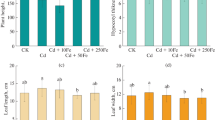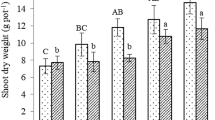Abstract
Cadmium contamination of agricultural soils is a serious problem due to its toxic effects on health and yield of crop plants. This study investigates the potential of low-dose nano-TiO2 as soil nanoremediation on Cd toxicity in cowpea plants. To achieve this goal, cowpea seeds were germinated on Cd-spiked soils at 10 mg/kg for 14 days and later augmented with 100 mg nTiO2/kg (nTiO2-50 nm and bTiO2-68 nm, respectively). The results showed that chlorophylls were not altered by nano-TiO2 intervention. Cadmium partitioning in roots and leaves was reduced by the applied nano-TiO2 but significantly higher than control. Ascorbate peroxidase and catalase activities in roots and leaves were promoted by nano-TiO2 intervention compared to control and sole Cd, respectively. However, magnitudes of activity of enzyme activities were higher in nTiO2 compared to bTiO2 treatments. The enhanced enzymes activity led to reduced malonaldehyde content in plant tissues. The study concludes that soil application of nano-TiO2 could be a green alternative to ameliorate soil Cd toxicity in cowpea plants.
Similar content being viewed by others
References
Abhilash PC, Tripathi V, Adil Edrisi S, Kant Dubey R, Bakshi M, Dubey PK, Singh HB, Ebbs SD (2016) Sustainability of crop production from polluted lands. Energy Ecol Environ 1(1):54–65
Aebi H (1974) Catalases. In: Bergmeyer HU (ed) Methods of enzymatic analysis, vol 2. Academic Press, New York, pp 673–684
Akanbi-Gada MA, Ogunkunle CO, Vishwakarma V, Viswanathan K, Fatoba PO (2019) Phytotoxicity of nano-zinc oxide to tomato plant (Solanum lycopersicum L.): Zn uptake, stress enzymes response and influence on non-enzymatic antioxidants in fruits. Environ Technol Innov. https://doi.org/10.1016/j.eti.2019.100325
Beyer WF, Fridovich I (1987) Assaying for superoxide dismutase activity: some large consequences of minor changes in conditions. Anal Biochem 161:559–566
Clement L, Hurel C, Mrmier N (2013) Toxicity of TiO2 nanoparticles to cladocerans, algae, rotifers and plants – effects of size and crystalline structure. Chemosphere 90:1083–1090
Cuypers A, Plusquin M, Remans T, Jozefczak M, Keunen E, Gielen H, Opdenakker K, Nair AR, Munters E, Artois TJ, Nawrot TS, Vangronsveld J, Smeets K (2010) Cadmium stress: an oxidative challenge. Biometals 23:927–940
Cuypers A, Hendrix S, dos Reis RA, De Smet S, Deckers J, Gielen H, Jozefczak M, Loix C, Vercampt H, Vangronsveld J, Kuenen E (2016) Hydrogen peroxide, signaling in disguise during metal phytotoxicity. Front Plant Sci. https://doi.org/10.3389/fpls.2016.00470
DalCorso G, Farinati S, Maistri S, Furini A (2008) How plants cope with cadmium: staking all on metabolism and gene expression. J Integr Plant Biol 50:1268–1280
del Rıo LA, Sandalio LM, Corpas FJ, Palma JM, Barroso JB (2006) Reactive oxygen species and reactive nitrogen species in peroxisomes, production, scavenging and role in cell signalling. Plant Physiol 141:330–335
El-Ramady H, Alshaal T, Abowaly M, Abdalla N, Taha HS, Al-Saeedi AH, Shalaby T, Amer M, Fári M, Domokos-Szabolcsy E, Sztrik A, Prokisch J, Selmar D, PilonSmits EAH, Pilon M (2017) Nanoremediation for sustainable crop production. In: Ranjan S, et al. (eds) Nanoscience in food and agriculture 5, Sustainable Agriculture Reviews. Springer, Cham
Fan X, Wang P, Wang C, Hu B, Wang X (2017) Lead accumulation (adsorption and absorption) by the freshwater bivalve Corbicula fluminea in sediments contaminated by TiO2 nanoparticles. Environ Pollut 231:712–721
Hund-Rinke K, Klawonn T (2013) Investigation of widely used nanomaterials and gold nanoparticles in standardized ecotoxicological tests. Published by the Federal Environment Agency (Umweltbundesamt), Dessau-Roblau, pp 10–13
Huybrechts M, Cuypers A, Deckers J, Iven V, Vandionant S, Jozefczak M, Hendrix S (2019) Cadmium and plant development: an agony from seed to seed. Int J Mol Sci. https://doi.org/10.3390/ijms20163971
Jozefczak M, Keunen E, Schat H, Bliek M, Hernandez LE, Carleer R, Remans T, Bohler S, Vangronsveld J, Cuypers A (2014) Differential response of Arabidopsis leaves and roots to cadmium: glutathione-related chelating capacity vs antioxidant capacity. Plant Physiol Biochem 83:1–9
Kim B, Murayama M, Colman BP, Hochella MF (2012) Characterization and environmental implications of nano- and larger TiO2 particles in sewage sludge, and soils amended with sewage sludge. J Environ Monit. https://doi.org/10.1039/c2em10809g
Larue C, Baratange C, Vantelon D, Khodja H, Surblé S, Elger A, Carrière M (2018) Influence of soil type on TiO2 nanoparticle fate in an agro-ecosystem. Sci Total Environ 630:609–617
Lee DH, Lee CB (2000) Chilling stress-induced changes of antioxidant enzymes in the leaves of cucumber: in gel enzyme activity assays. Plant Sci 159:75–85
Li J, Naeem MS, Wang X, Liu L, Chen C, Ma N, Zang C (2015) Nano-TiO2 is not phytotoxic as revealed by the oilseed rape growth and photosynthetic apparatus ultrastructural response. PLoS ONE. https://doi.org/10.1371/journal.pone.0143885
Lu J, Liu D, Yang X, Liu H, Liu S, Tang H, Zhao Y, Cui F (2015) Sedimentation of TiO2 nanoparticles in aqueous solutions: influence of pH, ionic strength, and adsorption of humic acid. Desalin Water Treat 57:18817–18824
Luo Z, Li M, Wang Z, Li J, Guo J, Rosenfeldt RR, Seitz F, Yan C (2018) Effect of titanium dioxide nanoparticles on the accumulation and distribution of arsenate in Daphnia magna in the presence of an algal food. Environ Sci Pollut Res Int. https://doi.org/10.1007/s11356-018-2265-y
Lyu S, Wei X, Chen J, Wang C, Wang X, Pan D (2017) Titanium as a beneficial element for crop production. Front Plant Sci. https://doi.org/10.3389/fpls.2017.00597
Mallampati SR, Mitoma Y, Okuda T, Sakita S, Kakeda M (2013) Total immobilization of soil heavy metals with nano-Fe/Ca/CaO dispersion mixtures. Environ Chem Lett 11:119–125
Nakano Y, Asada K (1981) Hydrogen peroxide is scavenged by ascorbate-specific peroxidase in spinach chloroplasts. Plant Cell Physiol 22:867–880
Ogunkunle CO, Varun M, Ogundele IG, Olorunmaiye KS, Paul MS (2018a) Citrus epicarp-derived biochar reduced Cd uptake and ameliorates oxidative stress in young Abelmoschus esculentus (L.) Moench (okra) under low Cd stress. Bull Environ Contamin Toxicol 100(6):827–833
Ogunkunle CO, Jimoh MA, Asogwa NT, Vishwanathan K, Vishwakarma V, Fatoba PO (2018b) Effects of manufactured nano-copper on copper uptake, bioaccumulation and enzyme activities in cowpea grown on soil substrate. Ecotoxicol Environ Saf 155:86–93
Ogunkunle CO, Bornmann B, Wagner R, Fatoba PO, Frahm R, Lützenkirchen-Hecht D (2019) Copper uptake, tissue partitioning and biotransformation evidence by XANES in cowpea (Vigna unguiculata L.) grown in soil amended with nanosized copper particles. Environ Nanotechnol Monit Manag. https://doi.org/10.1016/j.enmm.2019.100231
Ogunkunle CO, Odulaja DA, Akande FO, Varun M, Vishwakarma V, Fatoba PO (2020a) Cadmium toxicity in cowpea plant: effect of foliar intervention of nano-TiO2 on tissue Cd bioaccumulation, stress enzymes and potential dietary health risk. J Biotechnol. https://doi.org/10.1016/j.jbiotec.2020.01.009
Ogunkunle CO, Adegboye EF, Okoro HK, Vishwakarma V, Alagarsamy K, Fatoba PO (2020b) Effect of nanosized anatase TiO2 on germination, stress defense enzymes and fruit nutritional quality of Abelmoschus esculentus (L.) Moench (Okra). Arab J Geosci. https://doi.org/10.1007/s12517-020-5121-6
Rico CM, Peralta-Videa JR, Gardea-Torresdey JL (2014) Chemistry, biochemistry of nanoparticles, and their role in antioxidant defense system in plants. In: Siddiqui NJ (ed) Nanotechnology and plant sciences. Springer, New York
Servin AD, Castillo-Michel H, Hernandez-Viezcas JA, Diaz BC, Peralta-Videa JR, Gardea-Torresdey JL (2012) Synchrotron micro-XRF and micro-XANES confirmation of the uptake and translocation of TiO2 nanoparticles in cucumber (Cucumis sativus) plants. Environ Sci Technol 46:7637–7643
Servin AD, Morales MI, Castillo-Michel H, Hernandez-Viezcas JA, Munoz B, Zhao L, Nunez JE, Peralta-Videa JR, Gardea-Torresdey JL (2013) Synchrotron verification of TiO2 accumulation in cucumber fruit: a possible pathway of TiO2 nanoparticle transfer from soil into the food chain. Environ Sci Technol 47:11592–11598
Sharaf El-Deen S, Zhang FS (2016) Immobilisation of TiO2-nanoparticles on sewage sludge and their adsorption for cadmium removal from aqueous solutions. J Exp Nanosci 11:239–258
Song U, Lee E (2010) Ecophysiological responses of plants after sewage sludge compost applications. J Plant Biol 53:259–267
Song U, Jun H, Waldman B, Roh J, Kim Y, Yi EJ (2013) Functional analyses of nanoparticle toxicity: a comparative study of the effects of TiO2 and Ag on tomatoes (Lycopersicon esculentum). Ecotoxicol Environ Saf 93:60–67
Tumburu L, Andersen CP, Rygiewicz PT, Reichman JR (2015) Phenotypic and genomic responses to titanium dioxide and cerium oxide nanoparticles in Arabidopsis germinants. Environ Toxicol Chem 34:70–83
Wang P, Lombi E, Zhao FJ, Kopittke PM (2016) Nanotechnology: a new opportunity in plant sciences. Trends Plant Sci 21:699–712
Wang C, Du X, Liu Y (2017) Measuring spatial spillover effects of industrial emissions: a method and case study in Anhui province, China. J Clean Prod 141:1240–1248
Yang J, Cao W, Rui Y (2017) Interactions between nanoparticles and plants: phytotoxicity and defense mechanisms. J Plant Interact 12(1):158–169
Author information
Authors and Affiliations
Corresponding author
Ethics declarations
Conflict of interest
The authors declare that they have no conflict of interest.
Additional information
Publisher's Note
Springer Nature remains neutral with regard to jurisdictional claims in published maps and institutional affiliations.
Rights and permissions
About this article
Cite this article
Ogunkunle, C.O., Gambari, H., Agbaje, F. et al. Effect of Low-Dose Nano Titanium Dioxide Intervention on Cd Uptake and Stress Enzymes Activity in Cd-Stressed Cowpea [Vigna unguiculata (L.) Walp] Plants. Bull Environ Contam Toxicol 104, 619–626 (2020). https://doi.org/10.1007/s00128-020-02824-x
Received:
Accepted:
Published:
Issue Date:
DOI: https://doi.org/10.1007/s00128-020-02824-x







